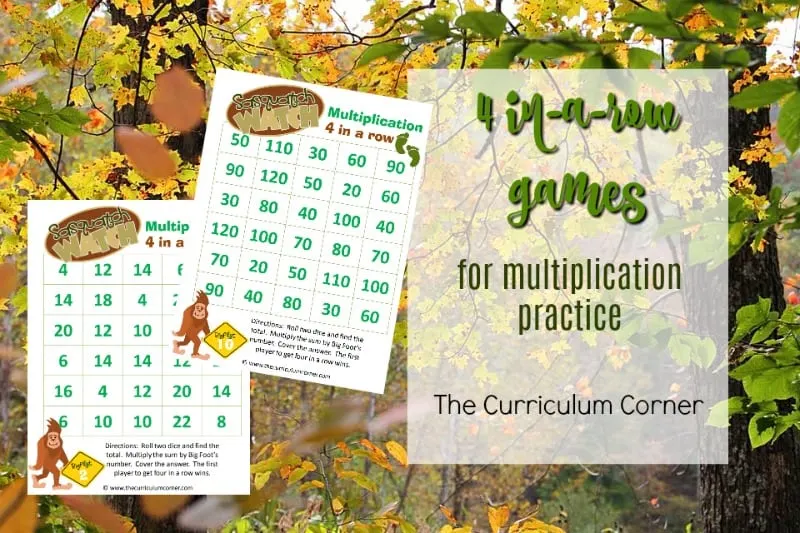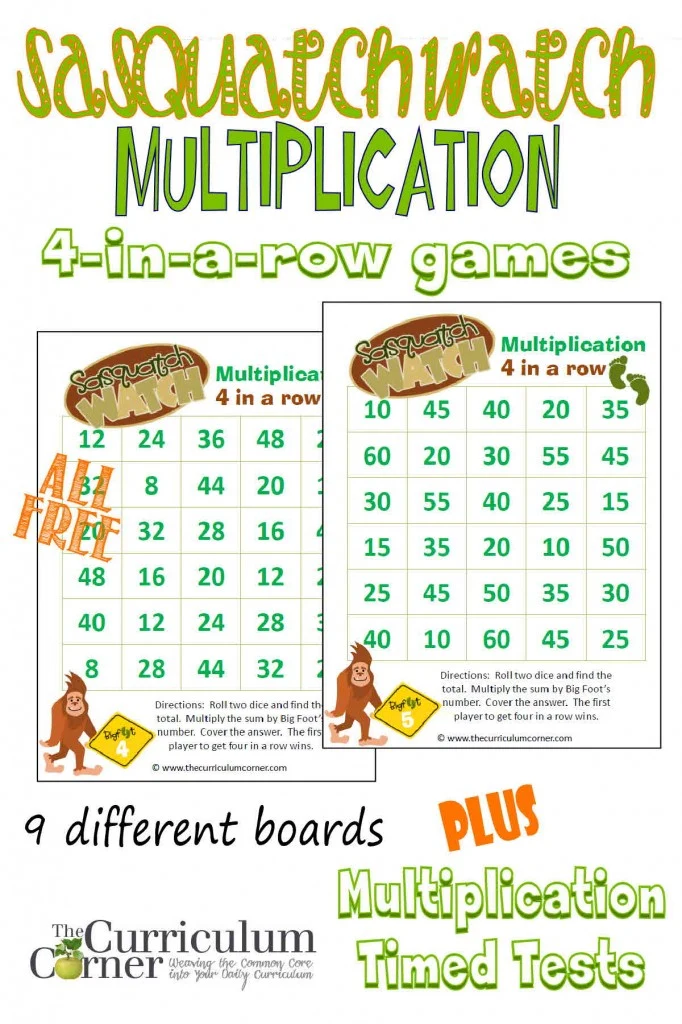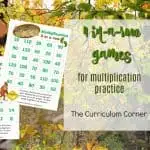These free multiplication games are designed for students working on mastering multiplication facts.

Most teachers will agree that mastery of math facts is essential in the upper grades. When students can’t quickly mentally add, subtract, multiply or divide two one-digit numbers it impedes their progress on more difficult math concepts.
In previous posts we gave our thoughts on incorporating timed tests effectively. Here we reiterate those ideas, but focus on multiplication facts and provide a multiplication fact game to help!
Scroll to the bottom of this post to find our free Sasquatch Watch Multiplication Games.
How to Incorporate Timed Tests to help your students with Mastering Multiplication Facts
To incorporate multiplication timed tests into our classrooms, we have students begin with 0s and progress through each level all the way through 5s. Then you can give them the mixed set of 25 problems (0s – 5s) so that they can prove they have mastered these lower levels.
Once the mixed set of 25 is passed with 100% accuracy, they may then begin work on 6s -10s. Again, provide the mixed set of 25 problems (6s – 10s) for the higher levels to make sure they have mastered those.
At this point they would take the 100 mixed problem test three times (with a 95% or higher score) to prove mastery of all multiplication facts.
We have read that research supports allowing approximately 3-4 seconds per problem to prove mastery. So, on the 25-problem tests we have created students would get 1 minute and 40 seconds to complete the test. At “time’s up” we allow students to put pencils down and complete any unfinished problems with a crayon. This gives them a sense of completion and also allows for a bit more practice. The score would be all correct answers in pencil out of 25. Also, we try to give these tests three times a week if possible. Because they are so quick, it doesn’t take up much of math time. Below is the link to our timed tests for multiplication:
Multiplication Timed Tests
If you still have students who need help with addition or subtraction facts you will find our most current posts with games included below. Both also have links to our updated timed tests resources which include both vertical and horizontal problem pages.
Strategies to Help Students Master Addition Facts
Strategies to Help Students Master Subtraction Facts
Keeping Timed Tests as Low-Stress as Possible
There is lots of debate about whether or not these types of timed tests are appropriate for all kids because they can sometimes create apprehension in students. Here are some tips for how we help kids master math facts using these quick assessments and also to alleviate anxiety.
1. Keep it individual. Give students sticker charts to keep track of their progress and encourage them to be private about their levels. Be sure to emphasize that learning math facts is something that is mastered based on practice, but it is most certainly something in which students will progress differently. As students pass different levels let them move forward, even as others have the need to take a level again and again. One way to manage this in class is to write names on individual leveled pages before passing them out and place them face down in front of each child. This certainly won’t keep individual levels a secret, but once you start the timer, students are typically more focused on their own pages. **TIP: Don’t let students stop working if they finish early. Tell them they need to double check as many answers as they can before the time is up.**
2. Keep it motivational. Be sure to celebrate ALL successes with students when it comes to improving on or passing a level. We like to give them a one-on-one smile, compliment and pat on the back the day after a timed test. Of course we also pass out stickers for their individual charts as they pass a level as well.
3. Keep in-class practice fun. As much as possible, provide not only the time to practice in class, but make it fun by finding or making up games. There are so many ways to practice math facts that are much more fun than “kill and drill”.
One quick and easy multiplication practice game involves decks of cards. Give each pair of students a deck of cards with the face cards removed – but be sure there are at least two jokers in the deck to represent zeros. Students sort the cards by suit (hearts, spades, diamonds, clubs) and then each student takes two of the piles, plus a joker. The game is played like war. At the same time both students flip a card over. The first one to mentally multiply the two numbers and call out the correct answer gets to take both cards for their own. (This game typically requires a time limit because – just like the real card game of war – it can go on forever!)
And here is a fun game we created for your kids to practice their facts:
Sasquatch Watch
More than anything, remember to keep things positive, hold conferences with students to discuss frustrations and ideas for better progress, teach differentiated strategies to help all kinds of learners, communicate progress with parents and help students set personal goals for mastery.
What are some ways you help students to master their math facts? Share them with us!


Natalie
Monday 19th of January 2015
I LOVE the idea of war as a multiplication fact game. I am in a rural area in Alaska where multiplication and division is not easily comprehended. I am hoping that using your curriculum and games will help them become and STAY motivated to keep learning. These students especially have a hard time staying attentive when their math time is over an hour. What are your suggestions for keeping their attention? I give them earned break time throughout the curriculum, but I'm afraid they aren't comprehending the material.
Jill & Cathy
Tuesday 20th of January 2015
Natalie, we think earned break time is a good idea! We might also suggest two to three short class movement breaks during the math hour - maybe after your mini-lesson or in the middle of independent practice time? Something structured (ten jumping jacks, quick stretches, a walk around the room) works well for our kids. We also love math centers. After your mini-lesson while you work with a group of students that might need further explanation of a previous lesson or today's (we all know who those kids will be ahead of time in most cases), plan three to four math centers or games for groups to go to to practice important math skills including the skill you just taught. (One of them could always be a simple practice of math facts with flashcards with buddies and another could be an independent practice page of the skill you just taught - not much prep for those!) The students don't need to visit all of the centers in one math hour, but maybe two to three (whatever you have time for). In our experience, when students know they won't be in one spot for too long, they tend to stay on task a bit better. :) Check out this blog post we found. It might help - http://www.3rdgradethoughts.com/2013/02/why-i-now-love-teaching-math-setting-up.html?m=1 Good luck!